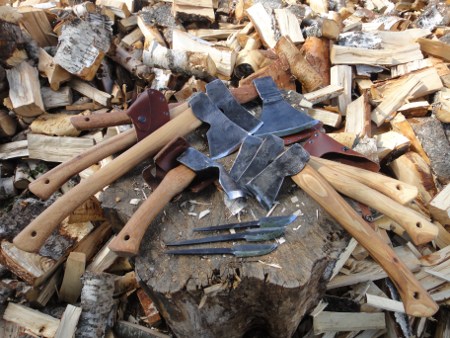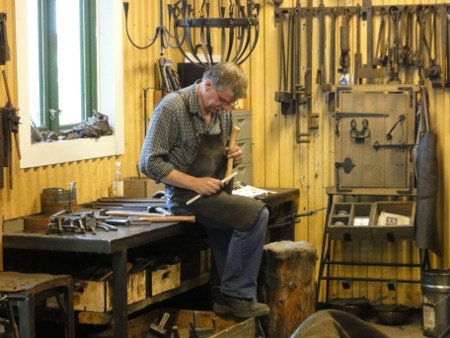
Gransfors has a forge, a pottery shop, a museum and a cafe. The first morning there, I took some time to wander around the shops and the museum. I watched and talked to one of the ax makers who has worked there for over twenty-five years.

They have had an unusually cool and wet spring in Sweden, and everything is very green. The flowers are gorgeous.

In the ax-making workshop that I’m taking, there are eight students, including me. The other students are from England, Denmark, France, Wales, Sweden and Germany. We are quite a cross-section from our occupations also, ranging from computer techs to military civil engineers and from gardeners (what we would call lawn work in the U.S.) to blacksmiths.

Lars Enander is teaching the class. Lars is a native Swede. His teaching method is European in that he wants to let you figure things out on your own. He kind of gets you headed in the right direction and lets you go without a lot of explanation. But he is also very willing to answer questions if you ask. He is a very knowledgeable and helpful instructor and went out of his way to make sure that I learned a lot during the class.

Lars started the class by giving us each a bar of 3 1/2 cm x 2 cm steel to make a slitter that we will use to punch the eye of our ax later in the class. We also made a set hot-cut from a piece of 33 mm x 37 mm bar. I also had time to make a drift. I also started making a candle holder and a rose while waiting for the other students to finish.

July 12: While the other students were finishing their hot-cuts and tongs, I finished making the candle holder. When everyone had finished the tongs that we made to hold our axes while we work on them, Lars showed us how to make a laminated knife blade by folding the end of a piece of mild steel flat bar (approximately 1/8 x 3/4″ flat) over 2 1/2″ or so and placing a piece of carbon steel the same width and thickness and two inches long in between.

We left a little space in the fold of the mild steel that will be welded and then drawn for the tang. We then forge-welded the “sandwich” and cut the bar off at an angle, removing the end of the welded pieces to remove anything that did not weld. The purpose of this exercise was mainly to give us practice forge welding carbon steel between mild steel, which we will be doing in making our axes.

July 13: I made three knifes before lunch, and Lars asked if there was anything he could help me make, such as tools I might need. I told him that I would like to make a scythe, but I didn’t know if that was something we could do. He said that he should know something about that . . . . So I made a couple of tools that would be used when shaping the scythe and started a small scythe, which I finished today. It was only about 18″ long and not perfect, but it works, and I learned a lot and had a lot of fun making it.

July 16: The last three days we have spent making axes! The method we learned is very old and was used in times past, when steel was hard to make and not readily available. They would make the body of the ax out of wrought iron and laminate a piece of steel into the edge, which is the only place that needs to be hard.

Thank you to everyone who contributed toward this trip.
Caleb Nolen

Caleb,
The trip sounds exciting. I am looking forward to talking with you again. Keep up the good work!
Terry
Thank you, Terry. I’ll pass your message along to Caleb.
—
Matthew